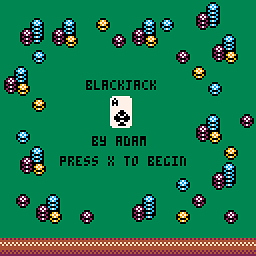pico-view:
June 2023

Hello Pico-View Reader, this June issue is the sixth in the series. This month the community has been brought together like never before!
Thank you to the writers, contributors, and all supporters, that includes you reader! We thank you from the bottom of our hearts. And with that, have fun adventuring through the pixels and paragraphs of this issue of the Pico-View web-zine!
Authors:
Ruvalolowa, RidgeK, Marina, Achie, and Nerdy Teachers
Contributors:
Jammigans, Ben Canfield, sika, Beravor, short_demand, Wolfe3D, Pico-8 Gamer, KumaKhan22
Special Contributors:
zep, Achie, Andrew Reist, BoneVolt, castpixel, David Fields, Doc_Robs, extars, Felice, Fletch, FredS, Gruber, Jammigans, Jakub Wasilewski, Johan Peitz, Jusiv, Krystman, Liquidream, Louie Chapm, luchak, Marina, NerdyTeachers, Noh, Nyeogmi, ohhhCurtains, paraK00PA, rare, shoma, short_demand, SlainteES, SmellyFishstiks, SquidLight, Uchuzine, Wolfe3D
Contents:
-Cover Art by Jammigans
-My PICO-8 Learning Journey - Ruvalolowa
-How to Write a Hit Song in 30 Minutes - RidgeK
-Featured Game Review 1: Porter - Achie
-Featured Game Review 2: 'Til the Gods Devour Us - Achie
-Finding Unity in the PICO-8 Community - Nerdy Teachers
-Featured Interview - Jammigans ft. Marina
-Let's Jam in July! - Nerdy Teachers
-Random Reviews - New Release Recommendations
-Pixel Art Gallery - BEN
-Prototype Party
-Closing Remarks
Also up to Now, Also Now,
Also From Now On
Also From Now On
My PICO-8 Learning Journey
by Ruva
Hello PICO-8ers! I'm Ruvalolowa, a Japanese newbie game creator. You can call me "Ruva" casually. I chose PICO-8 from many game engines and started game programming 1.5 years ago. There were 2 reasons.
First, is because I'm a big fan of 8 bit retro games, especially 2D platformers! Since junior high school, I have played a lot of them such as Kirby, Megaman, and so on in 3DS's virtual console. So I mainly play games like them now.
Second is because I wanted to make a mobile game. Maybe you think "Mobile game with PICO-8?", but actually they fit together so well. My first encounter with PICO-8 was "UCHU MEGA FIGHT", a pico-8 fighting game made by Uchuzine, a Japanese game creator.
↓ UCHU MEGA FIGHT

As you can see below, if playing PICO-8 games on mobile, PICO-8 has a virtual pad that fits both portrait and landscape modes. In addition they are playable on Lexaloffle BBS and Itch.io.
How to Make Your PICO-8 Game a Web App
If you add some codes to html file, it even becomes a web app! While Unity and X-code need complicated process to export the app, PICO-8 can do the same simply with "export ○○.html". That was so attractive for me, enough to buy it as soon as possible. PICO-8 is easy to play, and also easy to make games in as an engine / fantasy console.
↓ My work in progress series became web app

You can turn your PICO-8 game.html into a web app for iOS by adding some code inside the html between lines 3 and 4. You can use sublime or even the default notepad to edit.
Default first lines of the exported .HTML file
2 <title>PICO-8 Cartridge</title>
3 <meta name="viewport" content="width=device-width, user-scalable=no">
4 <script type="text/javascript">Insert these meta and link tags after line 3, so it becomes:
2 <title>PICO-8 Cartridge</title>
3 <meta name="viewport" content="width=device-width, user-scalable=no">
4 <meta name="apple-mobile-web-app-capable" content="yes"> <!-- Making this html into web app -->
5 <meta name="apple-mobile-web-app-status-bar-style" content="black"> <!-- Color of status bar's background -->
6 <meta name="apple-mobile-web-app-title" content="Game's title"> <!-- Title that will be set when you add it to homescreen -->
7 <link rel="apple-touch-icon" href="icon.png"> <!-- Icon when you add it to homescreen on iOS -->
8 <link rel="icon" href="icon.png" type="image/png"> <!-- Icon of browser page on PC -->
9 <script type="text/javascript">※ Changing e.src = "●●.js"; (around line 618) into e.src = "●●.js?"+Math.random(); makes it stable. These tips were shared to me by Uchuzine (previously mentioned). Thanks so much!
... Sorry, I have not enough knowledge to say it's "easy to do".
How I Started Learning
I started programming without any experience, so at first I struggled so much. But the PICO-8 community is so kind that there are a lot of tutorials; roguelike, shooting, adventure and so on. So soon I found Nerdy Teacher's platformer tutorial series and my learning began.
↓ Where my learning had begun

When I managed to make the base framework, I decided to add more systems next. Double jump, air dash, key & keydoor, enemy spawn, player attacks... As soon as I came up with an idea or a question, I wrote them down in a notepad. Sometimes games in the BBS inspired me. Especially "Mea's castle" by Astorek86 and "Ascent" by johanp helped me learn systems and code. Thanks so much!

↑ What I have made for 1.5 years.
- Switchable player & animate camera
- Large-sized player & melee attack
- Block's on/off gimmick with switch
- Outlines & gun attack & enemy spawn
- Aerials & hitstop & background cloud
- Door transition & circular fade & coins
Also there are a lot of kind people in this community. When I was stuck in coding and asked for help in the PICO-8 subreddit, they gave Great advice Quickly. It is FANTASTIC that there are people who help newbies, isn't it?
Tips for Other Learners
Now I'm gonna give some tips when you ask for help. The important thing is...
"Tell what you don't get in detail"
Even though someone wants to help you, sometimes it's impossible because of lack of information. Therefore, you should sum up what you don't get and what you want to do with that. Then let's ask, "How should I do it?" Adding screenshots, gifs or codes is effective, too!
Oh, and if you were given nice advice, don't forget to say thank you and change the post flair to "I Got Help - Resolved"!

↑ Kindness is something to be repaid.
In fact, I don't consider myself to be a good game creator yet. I have learned game programming just like practicing combos in a fighting game, buying new weapons in an RPG, or getting a powerup in a metroidvania, but it's still a work in progress.
I want to bring my WIP game "Variant Explore" and "Outvain" to completion someday … within 2023. So let's continue our game creating Odyssey. Also Until Now, Also Now, and Also From Now On!
How to Write a Hit Song
in 30 Minutes
in 30 Minutes
Basic Chord Progressions (Part 2)
by RidgeK
For new songwriters (and experienced ones), sitting down to write a new song can be an intimidating experience. Where to even begin? Lucky for us, and unlike so many things in life, there is a playbook that can help guide us to success!
Continuing from where we left off in Basic Chord Progressions (part 1), let's look at a different chord progression and explore some rhythms commonly used in pop music.
Lithography
Key
For simplicity's sake, all examples below will be in the key of C Major, using only the notes C-D-E-F-G-A-B.
Engraving
- Each sfx used in this lesson will represent 2 bars' (aka measures) worth of music.
- Each bar will be divided into 4 beats.
- Each beat is divided into 4 subdivisions, referred to as 16th notes or semiquavers.
- We can refer to each individual subdivision as an extension of the beat it belongs to, like 1, 1e, 1&, 1a, 2, 2e, etc.

When possible, we will try to visually organize our sfx so that they correspond with the patterns they've been assigned to. For example, pattern 00 will be assigned sfx 00, 08, 16, and 24. Pattern 01, will be assigned sfx 01, 08, 16, and 25, etc.

The Royal Road, IV, V, iii, vi
Like the Axis progression, the Royal Road progression is another chord progression popular enough to have its own name. This progression is prolific in contemporary Japanese pop music and named for its ability to be an easy hit-maker. If you're a fan of anime, this progression is the reason you love the title theme to every anime ever.
In the key of C Major, this chord progression will contain the notes:
| I | III | V
____________________________
IV F Major : F2 | A2 | C3
V G Major : G2 | B2 | D3
iii E minor : E2 | G2 | B2
vi A minor : A2 | C3 | E3
Let's try it out!

That sounds great. Let's make a song with this progression!
Clear a Path
Before we can begin writing our song, we're faced with a difficult choice. As mentioned in the previous article, we already know we're going to reserve channel 0 for percussion. That means if we want our song to have a melody, we will need to sacrifice one of our three sfx to free up a channel in the pattern.
Let's copy our pattern a few times so we can compare what it sounds like with one of each channels missing.
Copy and paste pattern 02 to patterns 03, 04, and 05. Then, disable channel 1 on pattern 03. Next, disable channel 2 on pattern 04. Finally, disable channel 3 on pattern 05. Play each one of these back and listen to the differences.

Personally, I think pattern 03 sounds the most interesting because it contains only the III and V notes, but not I, the root of the chord. It's a mysterious sound and invites the listener's ear to fill-in-the-blank. Let's make a song with it!
Copy sfx 18 to sfx 48, and sfx 26 to sfx 56. Then, create a new pattern 32, and assign sfx 48 and 56 to channels 3 and 4, respectively.

Beat 'Em Up
Add a basic drum beat to sfx 32, and assign it to channel 0 of pattern 32.


Don't Talk to Me or My Son Clave Again
Western pop music has a rich history, with major influences originating in music from Cuba and the African diaspora. Rhythmically, this manifests as various "clave" patterns, like 3-2 son clave#Son_clave). The 3-2 son clave looks like this in Pico-8:

That's a little fast for a pop song. We can play it in half-time by doubling the duration of each note:

Oops! All 3-Sides
"Pop clave" is a variation of son clave, where only the 3-side rhythm is played. This assymetric rhythm feels like it's constantly falling forward and anticipating the next beat. Playing the pop clave rhythm twice through in our pattern, it would look like this:

Let's try this rhythm out on our chord progression by making the V and vi chords hit two subdivisions earlier, so the chords will hit on the 2nd note of the pop clave rhythm, beat 2&. For example, pattern 48 will...
go from this:

to this:
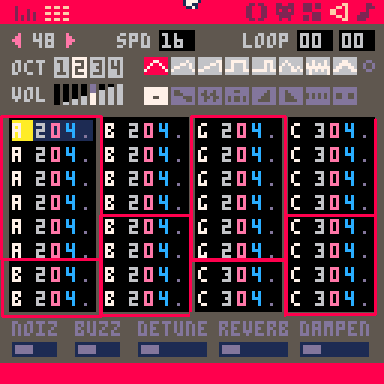
Repeat for pattern 56, making the D and E also hit 2 subdivisions earlier, on the 2nd note of the pop clave rhythm, beat 2&.

For the moment, we don't have a chord change on the third note of the pop clave rhythm, so we can only really hear the first two notes. If you like, you can use the fade-out effect ( 5 ) to re-articulate the V and vi chords and make the third note of the clave distinct:

The finished pattern:

Tension and Release
One of the things that makes the Royal Road progression feel so energetic is that it never resolves); that is, every chord in the progression carries tension and feels like it naturally needs to go somewhere else. Like the pop clave rhythm, the chord progression itself has its own sense of inertia. This is great for a while, but eventually we need to change things up for the listener and provide release.
Remember, our chord progression is IV, V, iii, vi. Notice how there's no I chord. We are in the key of C Major but the C Major chord is a place we haven't visited in our song! This makes the C Major chord the perfect candidate.
Begin by copying pattern 32 and incrementing the sfx numbers. Then, copy sfx 48 to sfx 49, and sfx 56 to sfx 57.

We already know that we are going to put our new chord change at the end of the progression, but where exactly?
We know that we want to provide a resolution at the end of the chord progression, so holding it for the final bar of the two patterns is a good choice. Replacing the two chords currently there with one single, long-droning chord, will give the listener a nice break. Additionally, we can take the listener by surprise if we make the chord hit a little early, like on the 3rd note of the pop clave rhythm, beat 4, before the final bar. Since our previous chord changes only happen on the 1st (1) and 2nd (2&) notes of the clave, the listener shouldn't be expecting a chord change on beat 4*, and they'll have extra time to appreciate that we've finally made it to the C Major chord.
Don't forget, we are only using the III and V notes of the chords in our accompaniment, which for C Major, will be E and G.
| III | V
______________________
I C Major | E2 | G2


At this point, we have all of our chord changes and can use them as a guide for expanding our idea further. We could modify our sfx and not have the chords droning for the entire progression, or we could write a bassline or other accompaniment that fits into these chords and rhythms, possibly without using the sfx we just made at all! For this lesson though, let's leave it here and move on to writing the lead melody.
Use Everything We Know
We have a drum beat and a solid accompaniment, so let's add a lead.
Begin by adding sfx 40 to pattern 32 and sfx 41 to pattern 33.

Writing a melody is a topic deserving its own article, or book, but we can quickly apply a few things we've learned already.
-
We've learned about the pop clave rhythm. Our backing track is already using this rhythm, so if we follow it for the melody, it will give the song a sense of unified energy. Perfect for the chorus of a pop song!
-
We know that our song is in the key of C Major, so our melody should use the notes C-D-E-F-G-A-B. We also know the notes in our chord progression, so a good rule to follow would be to only use notes in the progression's currently playing chord, unless we want to go out of our way to create melodic tension against the chord. This technique is referred to as "chord-tone soloing" and is an easy way to make sure your melody will sound good against the accompaniment.
-
We know that we've removed the root I note of each chord in our progression. The melody will be a good opportunity to restore the root when we really want to emphasize a chord. Since we went out of our way to resolve to the C Major chord at the end of the progression, this will naturally be a good place to use the root note in the melody.
Finally, there's a piece of information we've been missing. The Royal Road progression is actually IV7–V7–iii7–vi, meaning the first three chords contain an extra VII note. That's great news, because now in addition to I, III, and V being good candidates for the melody to land on, VII is also an option, if not a priority. Adding the VII where we can will create a lot of extra color and fill an important missing note in our chord progression, even more important than the already missing I note!
| I | III | V | VII
___________________________________
IV F Major : F2 | A2 | C3 | E3
V G Major : G2 | B2 | D3 | F3
iii E minor : E2 | G2 | B2 | D3
vi A minor : A2 | C3 | E3 | G3
At the beginning of the lesson, we changed our first version of the progression by inverting the chords and limiting them to a smaller range of pitches. We can also do that here by, for example, inverting the VII so it plays below the root I note of the chord.
| VII | I | III | V
___________________________________
IV F Major : E2 | F2 | A2 | C3
V G Major : F2 | G2 | B2 | D3
iii E minor : D2 | E2 | G2 | B2
vi A minor : | A2 | C3 | E3
Here's a melody that uses all of this information:
In pattern 40, we begin each phrase on the VII of the backing chord, move downard in pitch, and then jump back to the VII for the next phrase. Notice how the rhythmic phrasing mostly follows the pop clave rhythm.

When we begin the first phrase of pattern 41, this time, we go to the V of the backing chord. We could have used the VII again here, but by using the V, the first pitches of each phrase descend, E2, D2, C2. We slowly work our way down the scale until we arrive at C, the root, as if we're opening and closing a valve and releasing a little less pressure each time. This happens just before the chord progression resolves with the C Major chord, so the melody foreshadows the resolution for the listener by guiding their ear downward, towards the root.

Pick It Up
To finish it off, let's add a "pickup" to the melody, a few notes that will lead into the first beat of what we've already written. Begin by creating a new pattern 31, and assign sfx 33 to channel 1.
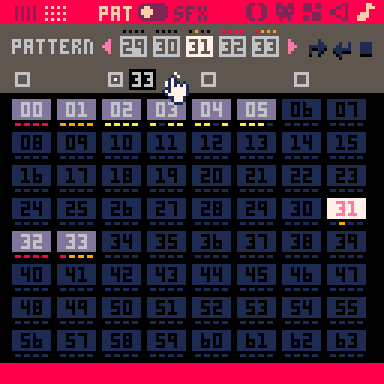
Next, add these 4 notes to sfx 33 and set the sfx len to 04.

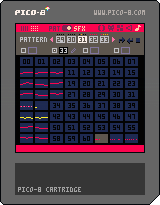
Next Steps
Congratulations, we've made a hit song! It's not exactly an entire song, and it's definitely not original, but I hope this lesson helps you understand a few of the things that make this such a catchy and timeless classic. With any luck, you can apply some of this knowledge to your own compositions and write your own hit!
A song doesn't have to stick to a single chord progression, and even if it does, the length of the chord progression can change and give a totally different feel to the song. Try extending the length of the Royal Road progression so it uses two patterns' length instead of one. Try combining the two chord progressions or rearrange them, for example, instead of starting on I of the Axis progression, try starting on the vi chord instead (vi–IV–I–V). Notice how this version begins on a minor chord instead of a Major chord. How do these changes affect the feel of the song?
At some point, you should write a new melody. You can use chord-tones, or the pentatonic scale is also a good choice. Before that though, keep this melody and listen for how it works or doesn't work against your modifications. Use what you've learned above to change the melody until it fits.
The next time you're listening to one of your favorite songs, listen carefully to the notes (or lack of) in the song. What is the chord progression? Does the lead melody follow the rhythms and pitches of the accompaniment? Look up the chord progressions for different songs you like and try combining them in different ways, with different rhythms, and try writing your own melodies over them.
Most of all, have fun!
- @ridgeK
Featured Game Reviews
Prepare for Trouble and Make it Double!
by Achie
This will be a harder one to start than the usual, as for this month we decided that we want to do a double feature! So let me roll up my sleeves and get into writing a double spotlight 2 days before the release. It’s not like they are keeping me as a Hostage in a cEllar, I swear I’m not Lying, Pinky promise.
So, you would think that waiting for two games for months would never lead to both of them releasing in the same one, right? Yeah, me neither and yet here we are! There aren’t any similarities in these games for me to tie them up and make like a joke of it … if only there was a magical portal that could lead from one place to another … oh wait!
PORTER
by blu
Waking up early, brushing your teeth, dressing up, getting the keys and driving 2 hours to work every day. You think you have it hard? You got nothing over poor Yug, who would love to take your place. He lives outside the city as he can’t pay rent (sheesh blu, I didn’t know this takes place in New York) so he has to take a dangerous and peril filled commute with sharp spikes, razor sharp fans, blocks than crumple away, HIIT training platforming and many more. Better be fast, so maybe they will give you a raise! Can you clock in early?

Porter is an awesome example for a traditional puzzle platformer by blu.
You run around ⬅️➡️ pointing your little teleport ability, and you can also press ⬇️⬆️ to aim it, you guessed it, up or down. You can jump with the 🅾️ and initiate a teleport by pressing ❎ which takes you to the pointed place! Easy as that!


Avoid the wall and the spikes and you will be fine! For the most part. Okay I lied you will die a lot in the grueling process of getting to work. Blu took this concept and added a lot of interesting stuff and puzzle elements to spice things up from time to time!
Take for example the switching blocks. Some are on, others are off, and upon stepping on the activation button, the states switch! This can lead to a lot of shenanigans, with you having to time your jumps, figure out new ways, and imagine if you had to time your jumps to avoid sequentially switching ones? That would be crazy, right?

It is, and let me tell you it is a lot of fun! Blue took all the nice puzzle elements you would want in a classic puzzle platformer (crumbling blocks, blowing fans, ...) you just wait to get to them and experience the cruelty of some levels first hand!
Level design is spot on all the way to the end! 29 levels of pure fun, which I highly enjoyed even though I died way too many times.
The game graphically is a minimalist masterpiece. 1-bit colored sprites sprinkle your journey all the way to the end, little ambient particles fly off to the distance, teleports feel and look nice, everything is just spot on.
Musically we have one track, to my knowledge, which is okay. It’s well put together, my issue lies with PICO-8 itself as it really sounds harsh to me with certain notes, and the OST has a fair few of those. Is it a problem for everyone? Probably not. Sound effects are well made; they feel nice and mellow to blend into the minimalist vibe of the game.
One really interesting fact for the game is that Blu went all out and put up two bounties for achieving certain ranks in the game! They were grabbed pretty quickly but it’s starting to take a tradition in his games, as the first one also had this! Even more, someone called rythin made a TAS (Tool Assisted Speedrun) which is basically an AI playing predetermined inputs. The human play WR as of now is 1:02 (https://www.speedrun.com/porter?h=Any_Warpless&x=xk91oe6d), which is crazy, I’m not trying to downplay that feat, but this TAS does this in 40 seconds. You blink and miss the whole game. Crazy.
Amazing game, try it out if you have a free half-hour or so! You won’t regret it!
No regretti, defend my peasantry! ヽ(o⌣oヾ) Transition God, wooo, let’s gooo!
'Til the Gods Devour Us
by Pedro Machado
If you browse around the PICO-8 Twitter, you surely have come across Pedro and his castle defending game at some point. I've been waiting since the very first gifs to get my hands on it.

We are tasked by protecting this little village from the seemingly endless army of the enemy, stretching through the horizon. Reinforcements will come in 5 days, or so we heard, but can we last that long in the endless siege? Heat the oil, sharpen the forks, we got a wall to defend!
TGDU is a blend between a roguelike, a tower defense and a micro RTS game in the small package of a PICO-8 cart. We’ve got three distinct phases so let’s break them down! (Not the walls, we want them)
Preparation!
During this phase we can exhaust our peasants to gain various action points to spend on upgrades and actions for this turn. These peasants are not usable in combat until the next day, so you have to be careful, but you can gain a lot by carefully balancing! Each action point costs you 5 peasants, and unspent points roll over to the next game. But let’s see what we can spend on!

| Boiling oil | You can set up a boiling cauldron in a wall section to be poured upon the approaching enemy! |
| Treat Wounded | You can heal up a random number of your lost troops, who have fallen in the last battle. |
| Train Peasants | Transforms a random number of peasants into better units! |
| Scouting | This gives away which wall is gonna get the weakest attack and how many enemies will be in said attack. |
| Caltrops | Slows incoming enemies down! |
Next, Deployment!
This is the part where you can assign various troops along your walls to defend. ⬇️⬆️ manipulates the number of the selected unit type, ⬅️➡️ will scroll through the troop types then move onto the next wall section according to the direction.
“What units?” you ask? Dark blue is your classic infantry, Light Blue is archers and Pink are your peasants! You can even hold back units to send them out as reinforcements during the battle phase which you cans tart by ❎. Here is me doing an awful job at this!

Once you are finished, then comes the most grueling part … the battle!
Battle!
This is where the big clash happens. Enemies will approach our walls, arrows will rain down, oil will pour and we pray that our forces are enough.


This is where the RTS part comes in, during this phase you can use remaining troops to reinforce, help parts of your defense that seemingly fall behind. If a part won, you can also regroup your troops to the new sections, all in one goal. Don’t let them get through!
In the end you will get a summary and a new day awaits, with a new action pool, and our dwindling forces must stand atop of the walls once again. Can we defend until the reinforcements come? Only time will tell.
The game, just as sieges, is ruthless. Do you want to heal your wounded? You have to give up peasants, but can you defend the wall without those peasants? Can you defend without healing your better troops?
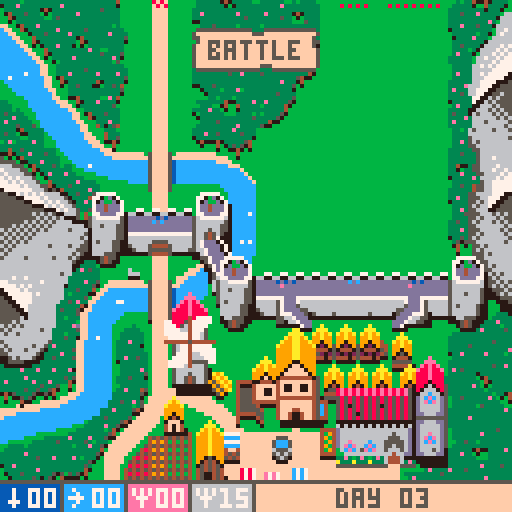

Can you afford to train your peasants and dwindle your precious action resource even more, with the hopes of those troops keeping up?
No hand holding for you, just the harsh reality of decisions and the need to give up something each day. Do we have enough men to defend to the last day?
I haven't yet, to be very honest with you. The game is a neat little dance on the tight resources you have.
In the graphics department the game has a really charming look to it. The village and the nearby forest and mountains look amazing. The troops are colored pixels only, but I think that’s a good thing. It helps to fit them into the graphic scale, and helps you sell the reality of war. Troops are just numbers, dots on the battlefield for you to push around and plan with.
Sound effects are nicely done, they are well fitted and the little OST tracks are well composed (although I ran into the issue of the battle song being too harsh to me), but the planning of the songs is a nice vibe for sure.
And yeah, this is the story of one of my runs. I spent too much on action points one day, which resulted in me having close to no units for the last day. We held the walls strongly, but in the last moment, the west part fell before our men could regroup …

‘Til Gods Devour Us is an amazing entry into the strategic side of the PICO-8 ecosystem, and will scratch my itch for a tense gameplay until I beat it one day! Amazing work, and highly recommend it to anyone for at least a few tries to get them to experience the tense “will we survive” helplessness of the village under siege.
About the Author
I stream PICO-8 gameplay and PICO-8 game development on Twitch, as well as write detailed dev logs and a game review series called "Pico Shorts".
Thanks for reading!
Finding Unity in
the PICO-8 Community!
the PICO-8 Community!
by NerdyTeachers
In the vast online realm, we PICO-8 enthusiasts find ourselves scattered across various social hubs and platforms, each engaging with the fantasy console in their own interesting ways. However, within this diverse landscape, an opportunity arises—to bridge the gaps, learn about each other's backgrounds, and celebrate the rich tapestry of our global community. Today, we embark on a journey of connection, as we strive to bring the community closer together, transcending social platform boundaries and discovering shared passions beyond the pico-pixels.
We interact a lot with fellow developers, ask each other for help, share our projects, and discuss game design intricacies. Yet, often unbeknownst to us, our fellow PICO-8ers hail from various corners of the globe, possess diverse hobbies, and have counted different number of trips around the sun. As a result, we often overlook the opportunity to forge connections, appreciate cultural differences, and discover our deeper commonalities.
With that in mind, this month we reached out to as many prominent and highly active members we could think of from each PICO-8 comunity hub, inviting them to participate in a wild idea. We really shouldn't be surprised anymore at how welcoming and friendly this community is but it is truly amazing that everyone responded so warmly and positively to turn our tiny idea into a massive reality. And so together, we embarked on the creation of a comprehensive catalogue—a mosaic of mini-biographies that shed light on the diverse individuals who make up our international PICO-8 club.
And so, we invite you to quench your curiosity and take the opportunity to learn about the humans behind the usernames and profile pictures we know so well.
Featured Interview
with Jammigans
ft. Marina
![]()
Marina: So, what got you started on pixel dailies, on the daily?
Jammigans: I want to do pixel art regularly, and pixel dailies seemed like a good format for making it a habit. I began creating pixel art dailies in August 2022 but often invested too much time in them, leaving no time for game development, which I also want to do regularly. Throughout the rest of the year, I struggled to balance the two, questioning whether I could maintain both regularly.
Early in 2023, I saw somebody on Twitter posting a set of small sprites they did as a daily pixel art challenge of 2022. Seeing that inspired me, and it got me thinking. If I limited the size of my dailies, maybe I could balance drawing and game development. Sticking with the PICO-8 palette that I love working with and have become comfortable with, I added a few constraints for my pixel dailies:
- 16x16 pixel canvas
- 60-minute time limit
- No animation
Setting up this set of rules for myself helped me keep doing pixel art daily while also being able to make games.
Marina: Oh wow, and these limitations have kept you consistent daily?
Jammigans: Pretty much! Sometimes I’ve missed a few days, and then I made sure to catch up. I wanna do the full year at least. I’ve broken the rules a few times as well... haha. The limitations have made it easier to “just do it” for sure.
Marina: Would you mind sharing your most recent work?
Jammigans: I made this Piranha Plant (theme ”piranha”) yesterday and just now finished one on the theme ”spark”.
Piranha Plant

Spark

Marina: lol, squiggles. Anyways, how is game-dev along side pixelart going, and how do you think your process might change in the future?
Jammigans: I can keep up with some game dev as long as I keep to my rules with the dailies. If I want to do any bigger pixel art project than the dailies, I pretty much have to pause game dev. Like right now, I’m working on the cover art for Pico-View, so I paused working on my game for a bit.
How might my process change in the future?
I’m not very experienced with programming, so most of my game dev lately has been based on tutorials, tweaking, and trying to make my twist on it. I’ll keep learning, and in the future, I would like to become more comfortable making games from scratch. Another way could be to collaborate with somebody who is good at programming. Then I could focus on game design and graphics. That might be even better, actually!
Marina: I think "tutorial-twisting" is where I got my start. It's inspiring how much art you've been able to create. I think we can all learn something from you. Anything you want us to know about you, and your process?
Jammigans: It’s nice to have someone else make a plan to follow and then diverge from that as you get ideas along the way. Following tutorials works pretty well for me to get inspired and get the creativity going. It’s like, ”What if I do this and change this into that” instead of staring at a blank screen trying to come up with ideas.
I ask myself what’s the most fun, what I want to focus on, and how much energy and time different projects take vs. what I thought they would. It’s good to do that monthly to keep focus and not get out of hand.
Marina: Ah, nice. Alright, well thanks for the interview, and could you give us your socials?
Jammigans: Thank you!
Let's Jam in July!
by NerdyTeachers
This month we receieved some exciting news about a greatly anticipated game jam approaching fast! Get ready for a heavy dose of inspiration and desire to make a game thanks to My Famicase Exhibit and AGBIC Jam!
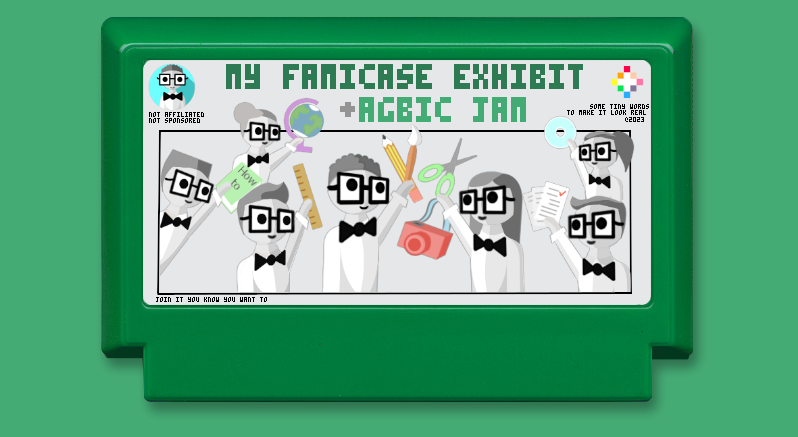
My Famicase Exhibit
For those captivated by the charm of classic gaming, which means ALL OF US, the My Famicase Exhibit stands as a beacon of creativity. Originating in Tokyo, Japan, this annual art event, organized by the METEOR video game store, invites artists from across the globe to design their own unique Famicom cartridge-label. The result? A stunning amalgamation of nostalgia, imagination, and aesthetic brilliance.
The Famicase Exhibit seamlessly blends the spirit of gaming with artistic expression. Each cartridge label features beautifully designed cover art, game titles, and even descriptions. These "famicases" transport us into vivid worlds teeming with untold adventures and untapped potential. And in that land, inspritation bubbles up like seafoam to fill our creative stamina bars.

If only there were a group of game developers to make...
A Game By Its Cover
As we immerse ourselves in the allure of My Famicase Exhibit, we can't help but feel a burning desire to bring these fictional games to life. And this is where the AGBIC Jam enters the stage! Short for "A Game By Its Cover" Jam, this thrilling game development event tasks you to create a game based on the artwork showcased in My Famicase Exhibit.

As you enjoy scrolling through the many Famicase artworks, find the one that sings to you like a muse, and then take off crafting a unique video game around it. Don't worry about tight time limits and competition because this jam grants you the freedom to unleash your creativity without the stress.
"As always you won't find any prizes, or rankings, voting or scoring here. We pride ourselves on distancing this jam from all forms of competition. Mostly because it's just unnecessarily stressful! Making things is hard, and releasing things into the wild is even harder. We see no reason to up the stakes even further.
"Take your time, take care of yourself, try it and maybe something will inspire you. And don't worry too much about the deadline, because we've made it kind of a tradition to extend it a bit every year." -Jam Hosts
Is there a Theme?
Yes, but it's totally optional! This year the theme is:
"up and not crying"
What are the Rules?
If you're already asking yourself a bunch of questions of what you can and cannot do, their FAQ sums it up nicely:
Frequently Asked Questions
Q: Can I-
A: Yes
Q: OK but are there any rules I should follow?
A: Only one, which we take very seriously: Respect the wishes of the original artists, and don't appropriate their designs without consent.
Even the questions you're surely thinking of, "Can I pick a famicase someone else chose?" and "Can I pick a famicase from any year?", the answer is still "Yes! Go for it!"
How do I contact the Artists?
First, go to My Famicase Exhibit and find the famicase you'd like to use. Click on the famicase image to view the title, artist info, and description. Often times it is not in English, so here's where you will find the artist name:

Another option is to browse the #famicase latest tweets to find the artists who have shared their famicase pictures there, and you can find their contact information on their twitter page or sometimes direct message them right there!
A third option is to join the AGBIC Jam Discord Server where the famicase artists themselves are sometimes members and fellow jammers often help each other find ways to contact the artist you are looking for.
On the Other Side of July
After you finish the rest of this Pico-View issue, visit the Famicase Exhibit, indulge in its visual wonders, and let your mind wander through the corridors of potential game ideas. And when the AGBIC Jam begins (tomorrow!), boot up PICO-8, summon your creativity, and join us in a month of easy-going game devving. You can even find teammates within the PICO-8 community if you don't want to do it solo.
The adventure awaits, my fellow PICO-8 enthusiasts. Let your imagination run wild, and may the My Famicase Exhibit and AGBIC Jam inspire you to create games that capture the hearts and minds of players worldwide. We'll see you on the other side of July, in the next issue!
Random Reviews
Game Recommendations on
New Releases: June 2023
ice breakers
"A lovely co-op, grid-based puzzle game, where you whack the ice but try not to make the litte cute penguin on skates fall in. Will have you smiling, thinking and whacking all day. Can also be played in single player."
-sika
Sprout
"A short platformer with exciting 'vegetarian' mechanics, where you use your magic beans to make platforms and make climbable vines. It is more exploration based and not heavy on the tight platforming. Looking forward where the developer will take the game to."
-Beravor
Confess
"A minimalistic gap-crosser. Jump from platform to platform across a 3D-rendered abyss. With different color schemes and a satisfying game loop, Confess is a joy to play."
-short_demand
Simple Blackjack
"A new port of an old game by fledgling developer SwimmMustache is exactly as described. And that can be a good thing! Clean UI, clear instruction, and appealing graphics make this edition of the classic casino game an easy pickup and play for any would-be card sharks. Missing game rules such as "splitting pairs" and "doubling down" would have been nice additions, but perhaps we can hope to see those in an "Advanced Blackjack" sequel from this promising first-time dev."
-Wolfe3D
Mystic Dungeon
"It's an amazing game. At first glance it may not catch you but I promise if you give it a shot you'll be sucked in. Definitely gives off eye of the beholder vibes so instant classic. Also very impressed with how the enemies are built out of coded shapes instead of pixel art, something I didn't know was possible."
-Pico-8 Gamer
Demo-Copter
"Demo-Copter is an amazing throwback to a 1-bit arcade style, score chasing, 1cc attempt game. Turn on the rotors, strap on a lot of bombs and let's flatten these abandonded districts. Can you bomb all the towers before flying into them as you descend? Let's see if you are a super player or just an avarage Joe!"
-Achie
Druid Dash
"A simple to understand puzzle game quickly pulls you in as the boards evolve from straightforward geometry to a more complex challenge as different elements come into play in later levels. Though the sprites are small and the movement is restricted to one direction at a time, the world feels large as you are dashing through it collecting magical mushrooms and overcoming the obstacles in your path. Optimization is the key word for this game for those who want to find the fastest way through this fun forest maze game."
-KumaKhan22
Pixel Art Gallery
Artist Spotlight: Ben Canfield


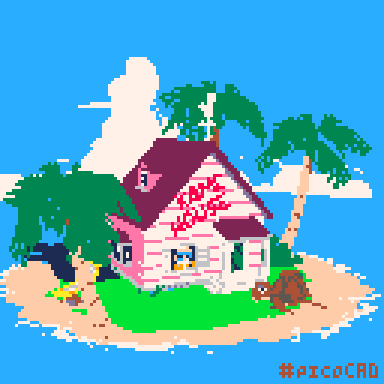
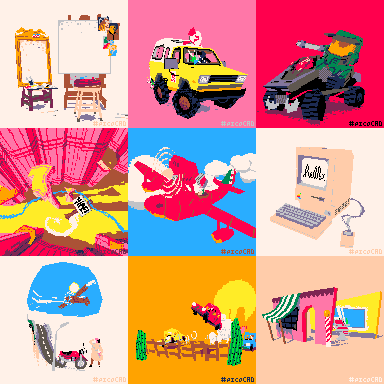
Howdy! I'm Ben. I've been making picoCAD models since it came out in early 2021, and I've been building models since taking digital art classes in high school nearly 20 years ago. In college, I originally studied Computer Science until taking an elective class on modelling where a professor said, "you know, you're pretty good at this!" I switched majors to Animation, worked on games and film in school, and briefly worked professionally as a 3D modeller for the game Octodad: Dadliest Catch.
Since then, I have switched careers and maintain 3D modelling as a hobby. Photography, illustration, and music are other interests of mine. I've enrolled in a figure drawing course this fall to help with my draftsmanship - hopefully it helps with conceptualizing a 3D piece before I throw down any polygons!
Immediately Johan Peitz's picoCAD caught my attention as it made the rounds on Twitter during its development. I hadn't been building models for a few years, and it gave a me breath of new creative inspiration. The distinct style, competitive jams, and supportive community have made it a joy to create with. One of the things I love about the program is how low the barrier of entry is - anyone at any skill level can pick it up and almost intuitively know how to start building their ideas. We continue to run weekly jams for people of all ages from all over the world with all different styles and unique skills. I love to see what everyone comes up with! Everyone there is an inspiration.
If you're looking for an introduction into 3D, or just a fun way to spend those creative juices, picoCAD offers the creative outlet to do so. Come by the discord and say hello! Share your creations, participate in the weekly jams, ask for help, or simply check out the art being shared!
Thanks for taking a look :) I hope you enjoy!
- @bencanfield.
Prototype Party
Each month, this section of Pico-View will bring you a prototype with a focus on a unique mechanic or style. You can take the challenge of putting your own spin on this prototype. Feel free to take the code from here and use it however you want!
This month's prototype is named "Sokolike". It is a template for building your own Sokoban-like game.
If you are not familiar with Sokoban, meaning warehouse worker, it is an MS DOS puzzle game from 1982 where you must push blocks around walls and other blocks to get them all to designated locations.


To make designing levels easier, we have included a level building function that will read each pixel in a 16x16 sprite and use that to place appropriate tiles on the map. This means that you can draw and edit your level designs easily using the sprite sheet! There are 16 example levels and 52 total levels available to be made.


Go ahead and tweak, add, re-theme, and build whatever you want on this and let's make some great puzzles! Try out our example puzzles right here:
We challenge you!
Take this prototype as a jump-off point to practice your skills, and add your own flavor to it. The only requirement is to make a sokoban-like game! We hope this inspires some creative new games, so take this template and see what you can do!
How to Share
You can post your spin-off on the BBS, tweet it with the hashtag "#picoview", and join our Discord community if you have questions or want to share your progress. Here is the game cart! You can save this image then drag and drop it into PICO-8 Education Edition to play and/or edit.

Closing Remarks
Thank you for reading the June issue of the Pico-View web-zine! We hope you enjoyed all of the articles this month. Here are the folks who helped piece the zine together one pixel at a time...
-Jammigans - Cover Art and Interviewee
-Ruvalolowa - Article Writing
-RidgeK - Article Writing
-Achie - Game Reviewer & Article Writing
-Marina - Interviewer & Zine-founder
-sika, Beravor, short_demand, Wolfe3D, Pico-8 Gamer, Achie, KumaKhan22 - Random Reviewers
-NerdyTeachers - Zine-Coordinator, Editor, and Article Writing
Thanks to all the authors, contributors, and readers for supporting our Pico-8 zine! If anyone would like to write an article, share pixel art, or help with anything contact @Marina Makes or @NerdyTeachers on twitter or Discord.
-Nerdy Teachers
16835
30 Jun 2023









